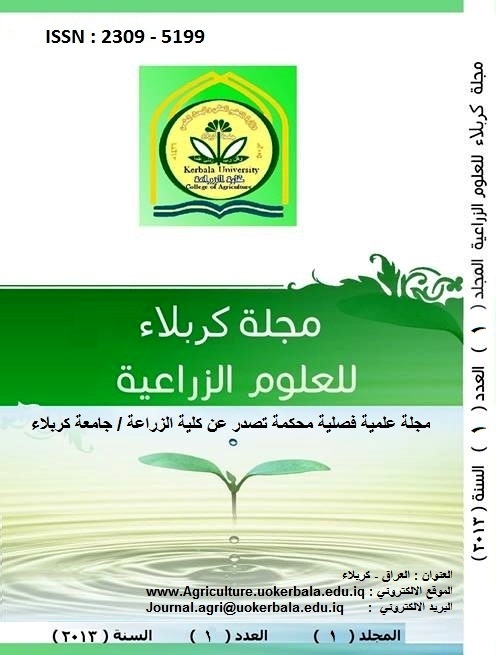Effect of organic ,chemicalfertilization and whey and on vegetative groweth of potatoes cv desiree
DOI:
https://doi.org/10.59658/jkas.v1i1.337Keywords:
Organic and chemical fertilizers ,Vegetable growth potatoAbstract
An experiment was carried out in the experimental field of Horticulture Dept., College of Agriculture, University of Baghdad for two seasons (spring 2007 and 2008)to produce potato by organic fertilization. In spring 2007 season, class A seed tubers while in spring 2008 season, class Elite of the cv. Desiree potato was used. Two experiment were designed, first was the use of three sources of organic fertilizers (Poultry, three levels of cattle and sheep manure)in addition to conventional mineral fertilizer and no fertilization (control) treatment. In second experiment, cattle manure fertilizer in addition to whey were used. Results could be summarized as follows:
- Soil added of 10% poultry manures hasten the field emergence and was 26.21 and 27.14 days. Cattle manure at 15% with whey had the lowest number of days for field emergence in both seasons (28.97 and 29.68 days respectively).
- Manure treatment regardless the source and cattle manure 15% +whey all caused 100% emergence for both seasons Greatest number of stems was found when 10% poultry manure was added (4.60 and 4.52 stem/plant) and 15%cattle manure with whey was added (4.44 and 4.36 stem/plant)for the two seasons respectively ).Total leaf area on the other hand was found in mineral fertilized plants for both seasons (34.30 and 33.30 dm 2/plant respectively ).Greatest dry matter percentage was found with 10% poultry manure treatment (56.29 and 55.27 g/plant)and with 15% cattle manure and whey treatment (56.20and 55.16 g/ plant) for the two seasons respectively.
Downloads
Published
How to Cite
Issue
Section
License
Copyright (c) 2013 Copyright (c) 2024 is the Author's article. Published by the Journal of Kerbala for Agricultural Sciences under a CC BY 4.0 license

This work is licensed under a Creative Commons Attribution 4.0 International License.
Licensing Terms
All articles are published under a Creative Commons License and will be directed to the Creative Commons Attribution 4.0 International License (CC BY 4.0) That permits use, distribution, and reproduction in any medium, provided the original work is properly cited. This license also allows the work to be used for commercial purposes.
Use by both non-commercial and commercial users
This content is licensed under a Creative Commons Attribution 4.0 International (CC BY 4.0) license, permitting use by both non-commercial and commercial users. Individual users may access, download, copy, display, and redistribute the articles to colleagues, as well as adapt, translate, and text- and data-mine the content, subject to the following conditions:
- The author's moral rights, including the right of attribution and the right to protect their work from derogatory treatment, are respected.
- Where content in the article is identified as belonging to a third party, users must ensure that any reuse complies with the copyright policies of the owner of that content.
- If the article content is reused for research or educational purposes, users should maintain a link to the appropriate bibliographic citation, including the DOI and a link to the published version on the journal's website.

